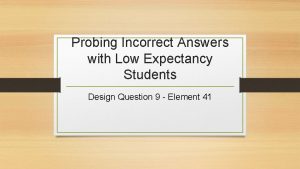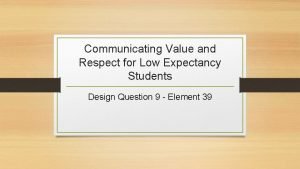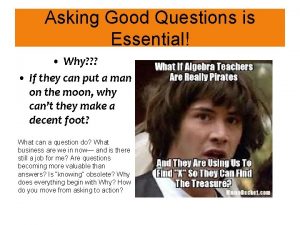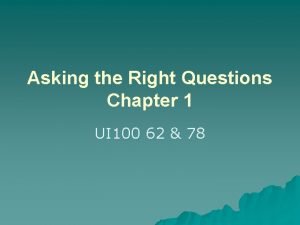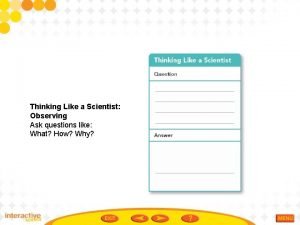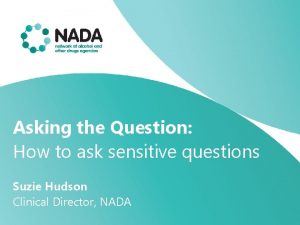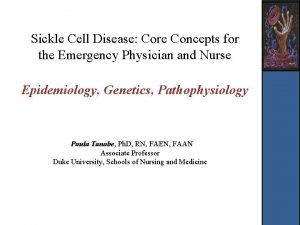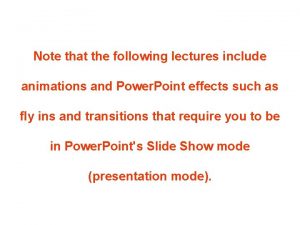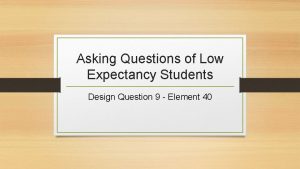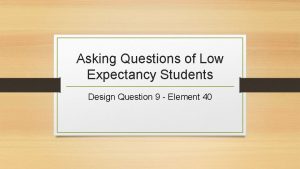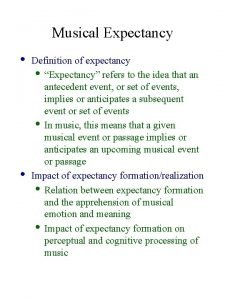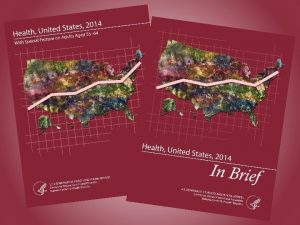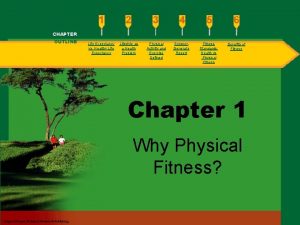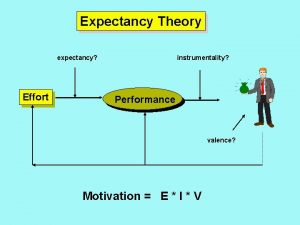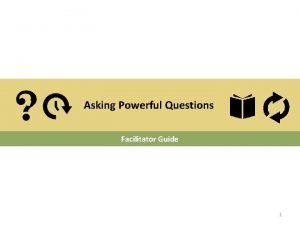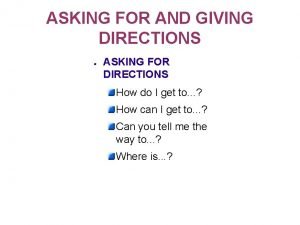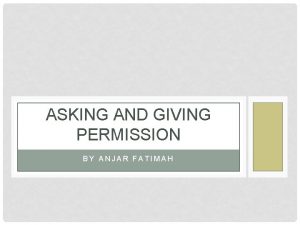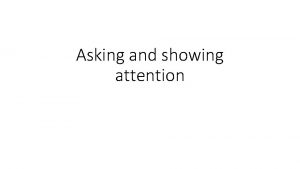Asking Questions of Low Expectancy Students Design Question





















- Slides: 21

Asking Questions of Low Expectancy Students Design Question 9 - Element 40: How do teachers ask both low and high expectancy students the same type of questions and at the same frequency?

Before we begin… Before we begin talking about element 40, let’s be sure that there is an understanding about how the elements in Design Question 9 are related. This is important as you plan your lessons. Directions: watch the video on the next slide. Please take notes, documenting how the elements in Design Question 9 are related.

Video – How do the elements in DQ 9 relate to each other? • Please click on the link to view the video from Pasco County Schools that provides an introduction to the elements in Design Question 9.

How do the elements in Design Question 9 relate to each other? What a teacher believes about the chances of student success influences the teacher’s actions with students. Design Question 9 addresses the notion that all students should feel that the teacher has high expectations for them. At the beginning of the video, they tell us the desired effect for the design question, which sums up the relationship between the three elements very nicely. By using these three elements, students will know you have high expectations for ALL of them.

Review Teacher and Student Evidence NOTE: This list of evidence is not all inclusive but is instead a list of possible examples.

Review Scale for Element 40

Desired Effect in the Students The desired effect for element is 40 is “all students are asked questions with the same frequency and depth”. To receive an Innovating rating, the teacher must monitor and make accommodations so that every student in their classroom achieves this desired effect.

Task While watching the below video, identify three reasons why it’s good for teachers to have high expectations for them, regardless of their current level of achievement. Click here for the video.

Video Question Q: What are three reasons why it’s good for teachers to have high expectations for students, regardless of their current level of achievement? A: 1. students feel good about themselves 2. students push themselves further because their teachers’ high expectations are a motivation 3. students work harder

Task While watching the video, identify questioning strategies Ms. Rodriguez uses with her ESL 2 nd graders to ensure they are all responsible for answering questions. After watching the video you will be asked to identify the teacher and student evidence to rate the teacher on this element.

Video Question Q: What are questioning strategies that Ms. Rodriguez uses with her ESL 2 nd graders to ensure they are all responsible for answering questions? A: 1. Ms. Rodriguez asks every student a question and they turn to their partners to discuss the answers. 2. Students ask their partners, “What questions do you have about soil? ” so that everyone is responsible for thinking of and answering a question. 3. Students are broken into a smaller group that is teacher-led so that Ms. Rodriguez knows that every student is successful. 4. At the end of the lesson, every student is asked “What did you learn today? ” and then shares their answer with the rest of the class.

Task On the next slide is the teacher and student evidence. What evidence did you see in the video and were able to document? Use this to rate the teacher as you walk through the next few slides.

Review Teacher and Student Evidence What did you see?

Review Teacher and Student Evidence What did we see?

Review Teacher and Student Evidence Teacher Evidence • Teacher makes sure low expectancy students are asked questions at the same rate as high expectancy students. • Mrs. Rodriguez asked every student the same question and required every student to answer the question by sharing their answer with a partner. • Teacher makes sure low expectancy students are asked complex questions at the same rate as high expectancy students. • Instead of calling on just one or two students, Mrs. Rodriguez asks every student the same questions and requires all of them to answer the questions. She then monitored for correct answers by walking around to listen to group discussions or look at written answers.

Review Scale for Element 40 to Rate the Teacher

How we Rated the Teacher We rated this teacher as Innovating. She asked the whole class the same questions and provided individual students with resources to make sure every student was successful. For example, lower-achieving ESL students had to answer the same complex question as the other students but to help them, Mrs. Rodriguez placed them in a small group so she could work with them on a more personal level. She also provided them with a lower level English book about soil that included more pictures. Finally, she allowed her ESL students more time and opportunity to practice their new academic vocabulary. In doing these things, Mrs. Rodriguez ensured that all students, regardless of their academic achievement, could be successful answering complex questions.

Additional Marzano Resources First, log into www. effectiveeducators. com. Second, click on Resource Library and search for these resources. 1. Strategies for DQ 9 E 40 2. Read & Reflect DQ 9 Identifying Students

Additional Resources • Click here for a video about how to use questions in your classroom, involving all students. • Click here for a video about how to probe students instead of just a few. • Click here for a video about five questioning strategies to ensure low expectancy students are receiving the same education as other students. • Click here for a video that describes questioning strategies that involve all students. • Click here for Chapter 8 titled “Differentiated Instruction: High Expectations for All”. Figure 8. 1 is a great way for you to determine how you treat low expectancy students differently. The rest of the chapter provides easy-to-implement strategies for fairly treating all students.

Is this element in your PGP? Then you need to… 1. Sign into www. effectiveeducators. com. Click on the Growth tab and then click on the Plans option. Open your current plan and fill out a new Reflection Log, answering the appropriate questions. 2. Decide how you will change your teaching as a result of viewing this module. 3. Execute your change, reflect on its impact, and fill out another Reflection Log in i. Observation.

Further questions? Here are resources in case you have further questions: - Your evaluator - Another evaluator on your campus - Your school’s Classroom Practice Mentor (CPM)
 Probing incorrect answers with low expectancy students
Probing incorrect answers with low expectancy students Demonstrating value and respect for low expectancy students
Demonstrating value and respect for low expectancy students Costa 3 level questions
Costa 3 level questions Asking essential questions
Asking essential questions Positive tage
Positive tage Present continuous tense in hindi
Present continuous tense in hindi Sponge and panning for gold approach
Sponge and panning for gold approach Observing and asking questions
Observing and asking questions Asking sensitive questions
Asking sensitive questions Asking scientific questions activity
Asking scientific questions activity Answering questions in spanish
Answering questions in spanish Middle = low + (high - low) / 2
Middle = low + (high - low) / 2 Director communication style
Director communication style High precision vs high accuracy
High precision vs high accuracy Low voltage hazards
Low voltage hazards Rizal carved the image of the blessed virgin mary on a
Rizal carved the image of the blessed virgin mary on a Life expectancy of sickle cell patients
Life expectancy of sickle cell patients My favourite animal is panda
My favourite animal is panda Down syndrome life expectancy
Down syndrome life expectancy Why does a star's life expectancy depend on mass
Why does a star's life expectancy depend on mass The expectancy theory
The expectancy theory Island with longest life expectancy
Island with longest life expectancy
